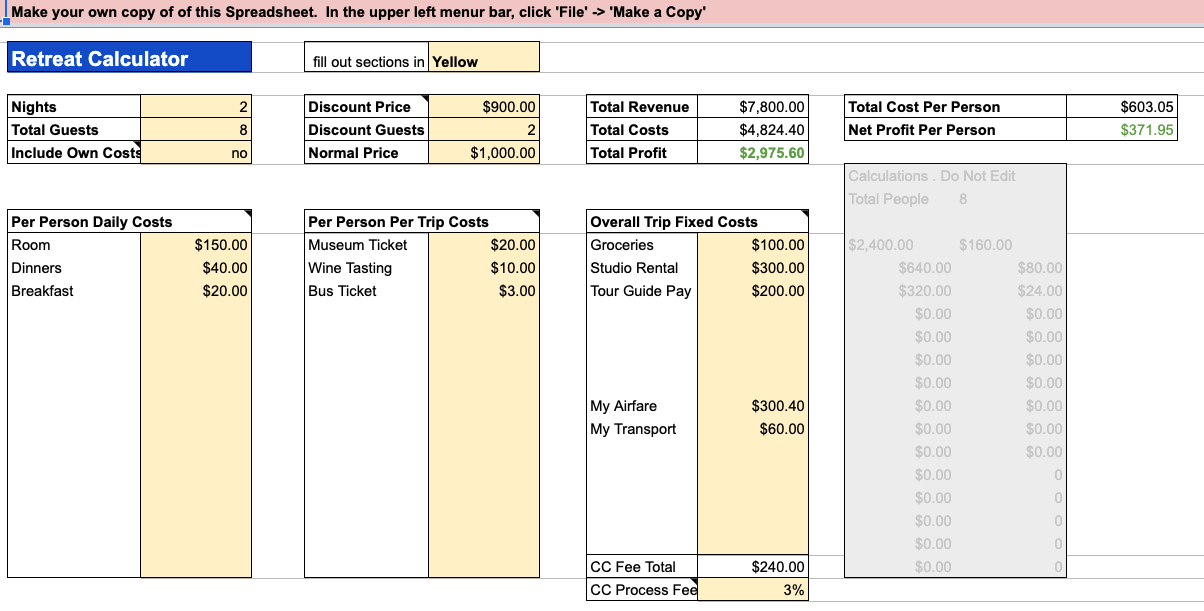Planning a yoga retreat can seem overwhelming at first. In our most recent Uplifted masterclass for yoga teachers, Yoga Retreat Magic, we touched on all the steps (scroll down for the video).
Many components go into a retreat and it can make the planning process difficult to navigate.
To ensure that it is profitable and leaves your customers wanting another, already budgeting for their next retreat with you, make sure that you have these following five questions answered FIRST.
1. How is the retreat transformative for your ideal student?
Is it designed to deepen your students’ practice? Embody a concept from yogic philosophy? Related to a chakra, theme, or type of healing journey? What transformational experience are you designing? Maybe you want students to have the intention of letting go of something that is holding them back. Or maybe this retreat is geared towards mothers and daughters. Or those dealing with addiction. Or those who want to become more empowered through yoga! WHO precisely is your retreat for? And why is that inspiring to you?
2. What beautiful destinations enhance your theme?
Create a list of destinations for both domestic and international retreats. With this list, consider the time of year you want to go. Which of these amazing places will help facilitate healing and growth for your ideal client or student? And build or enhance the theme or yoga classes you’re designing. Once you’ve narrowed your list down, conduct research into each destination to answer the questions of it being budget friendly, safe, other activities outside of yoga and meditation, and accommodation options for your guests.
3. What is your mindset? Are you okay with uncertainty?
You’ll want to make sure that you are showing up for your students as the leader and healer that you want to be in this world. Know that mistakes and mishaps will happen, but it is all part of the amazing experience that you’re providing your students! Our panelists have great things to say about mindset in the video below. This aspect of teaching and leading a retreat is critical. It all starts with YOU.
4. How far out should I book this yoga retreat to allow myself enough time to get the details ironed out?
Most retreats (especially international) take a year or more to plan. Start working backwards from your proposed date and think through all the different aspects, from international visas, to gift bags, to airport transfers, to student payment plans, to the marketing plan that you’ll need to architect. Use the excel retreat calculator and example financials within our 300-Hour Yoga Teacher Training to help with this first step. 
5. Do I utilize the help of a retreat center or not?
Should you be in the midst of organizing a yoga retreat and choose to use the help of a center, you will find that many are incredibly helpful and have “all inclusive” pricing for food and lodging. This can create an almost “done for you,” “no worries” experience. However, there are many retreat centers and companies out there. Not all are created equal. Do your research into each company. Visit if possible or ask other yoga teachers for recommendations. Ensure that they meet your expectations and are aligned or hold similar values as you do for your students and retreats.
If you don’t want to use a retreat center, then you’ll want to plan for things like where you’ll take your yoga group. I’ve often rented space at local yoga studios in the cities I’m hosting my retreat in. Will the place you want to bring them have enough space? What other non yoga activities will you have planned? And of course the other travel costs associated with that destination (food, accommodations, vehicle rental or other modes of transportation) all need to go into your budget. You’ll also want to consider maybe utilizing a local guide to show you and your yoga group the best spots or “hole in the wall” spots that you may not have known about.
Watch our full “Retreat Magic” video and hear directly from our panelist here:
Budget Your Yoga Retreat for Profitability
Budgeting any large trip, yoga retreat or otherwise, always comes with SO MANY questions! For many this is where it gets to be overwhelming because of all the nitty gritty details and costs involved with travel both domestic and international.
Calculate all your expenses in excel or google sheets
Use a spreadsheet so you can plug in all of the numbers and see them update in real time! Whether this is your first yoga retreat or your 15th you’ll need to consider the following aspects:
- Travel expenses while en route to the retreat location, when everyone lands and how they’ll get to the place you’re staying.
- Other costs associated with travel such as taxes, processing fees, resort fees if any and transportation around the area your yoga group is staying.
- Are you booking airfare for everyone or does your retreat price take care of the travel once everyone has arrived in the destination airport?
- What is the high end and low end cost?
- If you’re traveling internationally, what is the exchange rate?
- Have you taken into account YOUR meals, flights, lodging and expenses
- What about money for your teaching class?
Budgeting in partnership with a retreat center
- What are the costs of meals?
- Are they flexible with people who have food allergies, do they have healthy food options?
- Is there a rental fee for the venue or yoga studio?
- How many students does the yoga space hold?
- Will there be other yogis or yoga groups there?
- What percentage of your profit would they take?
Budgeting without a retreat center
- Are there yoga centers in the area?
- What are each of them like and what are the fees to rent their studios?
- Do you plan to travel around the area?
- If so, what are other expenses for hotels, transportation (buses/taxis).
- If you plan to have free time during the retreat what do other activities cost?
Brainstorm hidden fees
A common mistake in the planning process is looking over expenses that may typically be looked over, for example credit card processing fees, your marketing ad spend, or resort per person fees. Especially if your group is international, this will be something you’ll need to ensure you look into so that you and your group are not blindsided.
Another common mistake while planning yoga retreats happens while looking at the time of year that you want to take your yogis to the retreat location. This is one of the key elements to look into because major holidays or celebrations like Carnaval in Brazil or Fashion Week in Florence may lead to higher costs. It’s also important to consider the time of year that you want to travel because of the weather. It may be less of an enjoyable experience for your students and yourself to go somewhere like Costa Rica during their rainy season.
How to Price Your Yoga Retreat
Pricing your yoga retreat can sometimes feel icky or uncomfortable for many reasons. This is why I created an entire money mindset training for yoga teachers! As yoga teachers, we want to bring peace, knowledge, growth and healing to all of our yogis.
Fall in love with my 300-Hour teacher training or …
It can be difficult to create a happy marriage between the amazing yoga retreat experience that you want to cultivate and the price you need to charge to make the experience worth your time and effort. You may be thinking, ‘Yes this is super not fun to think about. I just want to have an amazing group of people surrounded by fellow yogis who want to grow, heal, and make those positive shifts in their lives!’ Of course that is the end goal! However, to ensure that this yoga retreat is not the only amazing experience you will ever be able to provide to your students, the price point needs to be there so future yogis can benefit from your life changing teachings.
For those planning your first retreat and choosing to book through a retreat center, they may be able to run all of the numbers for you while keeping in mind your profit as well as theirs. Some may also work your travel and accommodation into the price so that you’re covered.
Set your target profit first
When planning a yoga retreat, have an ideal number in mind that you want to profit. What will make running all aspects of this experience (including the marketing and admin work) worth your time? Utilizing a spreadsheet that is created with a retreat company, you will be able to see how much you will need to charge per person to meet your ultimate goal. This is important information to know so that you have a goal number of attendees to have in your group to ensure that this retreat is meeting your financial expectations.
If you have decided against using a retreat center, you’ll want to again have a number in your mind that will make the experience worth your time.
Look in Module 3 of 300-Hour Yoga Teacher training for all the details around budgeting and marketing yoga retreats, and how to adjust your price to cover your costs and ensure your time and effort is accounted for.
How to Market Your Yoga Retreat
Alright so now you’re at the point in the planning process where you know where you want to take your yoga group, you know the price, and you’re ready to start marketing!
This is so critical to have a successful retreat, not only for you to meet your financial goals, but this also sets the tone for enticing your students to join you in this amazing opportunity. The marketing phase is really where you get to showcase how much fun this retreat is going to be for your students!
Think about where your students like to interact with you
If you’re someone with a smaller or larger following consider asking yourself the questions:
- How do I entice students to join me?
- How do I keep them coming back?
- What platform do I market this experience on?
Create an FAQ Email before you launch
First things first, have all of your logistics sorted! Make sure you have all of the information possible so that you can answer all the student questions that will come your way. Go into the marketing phase with the intent to have consistent and clear communication. This can be in the form of a Retreat FAQ to send students.
Leverage your time with crossposting
If you want to launch your retreat on Facebook, make sure that you have your Instagram linked as well so that it reaches your followers on both platforms – eliminate the extra time spent on composing two different posts.
“Soft launch” with bonuses, discounts or incentives
It may also be beneficial for you to do a soft launch with people that have been attending yoga retreats with you before. That way they get the warm fuzzies about being the first to know. Have a call to action to reserve their spot before others jump on board by offering early bird pricing, special gifts or bonuses!
Visually show off where you’re going
Once you’ve got the word out about your retreat and your students start to ask you all the questions, post some videos of the place that you’re going. Have fun with this and showcase details about the location.
Be consistent
Remember, the retreat experience starts when your students sign up. Keep them engaged and excited! Every couple of weeks, you can give them hints about what the retreat will bring – this also encourages those who are looking at your retreat to join!
Host and Info Session
It may also be beneficial for you to have an info session or two where you invite your students to a Zoom call or better yet an in-person get together to answer any questions.
When you’ve closed the sign up process or have met the maximum number of yogis attending, this is when you can plan a super fun Zoom style or in-person kick off party! This is the time to really seal the deal on their excitement and get them thinking about all the amazing things you will all be doing! You can go over the itinerary and tell them what the day to day looks like, if you have other activities planned you can give them the details on that as well. A kick off party is also a great time to get any paperwork like liability waivers signed/witnessed so that once they land they don’t have to be side tracked from the experience with paperwork.
Save Hours with my Proven Formula. FREE Yoga Business Plan Download

YOU are the Energy of Your Yoga Retreat
Let’s be honest. It can be so difficult to be “on” for a long period of time. We’ve all had days where when we get to the studio or prep to teach yoga classes and we have the feeling of ‘ugh I love this and I want to do this, but I don’t have the energy that I would like to have today.’ This is totally okay and valid to feel – we’re human! When it comes to a yoga retreat, if you’re nervous you’ll need to be on and have high energy each and every day, bring a fellow yoga teacher with you. This allows you to have someone to co teach with or even give a budding teacher the opportunity to share their teachings- you can even learn from them! Having someone else there with you who can teach can also give your yoga retreat an extra element of value that is beneficial for you and also gets your yogis excited.
To ensure the energy you put out throughout the duration of your retreat, incorporate some alone time for you as the leader. Make use of journaling sessions where you encourage your yoga students to take an hour or two and sit on the beach or any space that allows them to have peace and find clarity so they can write in their yoga journal about their experience and any shifts or intentions that they want to hold each day. This will allow you the time you need to journal as well but also to breathe and collect the energy.
By the way, it’s not a secret that energy is contagious. If you’re excited and pumped to get deep into your yoga practice, your students will be too.
Hosting a Yoga Retreat FAQ
Q: What is the ideal retreat length?
A: If this is your first retreat, first congratulations you’re going to do amazing! Second, don’t stress yourself out with trying to plan a week to two week long retreat. You may find that you bit more than you could chew and feel frustrated and turned off from planning another. It’s totally okay to plan for a short long weekend retreat in a local spot so you get your feet wet! Your students already love you and once they see how retreats with you are, then you can start to branch out and plan longer, more extravagant retreats to beautiful destinations.
Q: What about insurance, licensing requirements, etc. for out of state or international travel?
A: All the normal business licensing needs to be in place. Some insurance that covers you both locally and internationally. Pro Tip – make it known that trip insurance is not provided but required as in many cases that will be the means for a refund. Have clear communication throughout the retreat planning process!
Q: I have difficulty figuring out how much I am actually making for all the extra time I spent with students on the retreat. Do you set a goal rate for the class and another rate for being a “travel concierge” and “interpreter”?
A: To keep it simple it would be beneficial to have a price that encompasses all that you’re offering! It takes a lot of your time and energy to not only conduct classes but to also ensure that everyone is having a great time and isn’t feeling lost or as though they’re just along for the ride.
Q: Should I use an application for my retreat or just allow people to sign up?
A: Applications can deter yogis to join because they may feel they are being judged, or that the experience is elitist – not a great first impression or bonding experience with you. If you have a clear intention in mind of the trip that you’ll have, it should attract the right people. Yogis will know based on you, your marketing, and the trip details if this is the right fit for them – don’t over complicate it!
Q: Do you advise collaborating with any other yoga teacher/coach/healer, or is it better to run it by yourself?
A: It can be beneficial if you’re just getting your feet wet to have another facilitator join you as you can collaborate together and not feel as overwhelmed. It can also be a fun experience for your yoga students as they can have two incredible teachers guiding them during the trip. If you’ve already organized many yoga retreats, then it may be easier for you to run it by yourself. You’ll need to make sure that the price point that is offered meets your financial goals with or without an additional teacher.
Q: How do you lead a trauma healing retreat without having a room full of crisis/triggering each other?
A: Yoga is a healing practice and people turn to yoga for various reasons. You may want to have someone come with you as a cooperator to help manage the group. A psychologist who happens to be a yogi may be incredibly beneficial for you! You can also make time in the day to have one on ones with a yogi who would like to talk through any issues they may be having.
Q: How do you navigate having multiple people organizing a yoga retreat together?
A: We all know that sometimes shaving too many hands in the cookie jar can make a planning process more difficult. It would be beneficial to have a small group of two that are primarily organizing the trip. Any other facilitators can offer suggestions and help to identify any potential issues along the way.
Remember, you have what it takes to be a retreat leader. Many yoga teachers lose money on retreats because they don’t do the proper budgeting in excel, miss expenses, or make their retreat price too low. Spend time digging into all the details. Know the minimum number of students you need to hit profitability. Make sure to watch the full Retreat Magic Masterclass video for all our retreat planning tips, and circle back to Module 3 in 300-Hour Yoga Teacher trainings which has incredible resources around everything from money, classes, location, costs, venue with example financials and sales pages. You got this!
Next Steps:
- Explore my Yoga Teacher Resource knowledge hub for more tips about how to grow your yoga business.
- Download my sequences for a jumpstart on your upcoming yoga classes!
- For more detailed tips, processes, and worksheets to supercharge your yoga business, download my yoga business launchpad course!

Sneak Peak into My 300-Hour YTT - FREE Videos, Info Session, Bonuses!

YOU MIGHT ALSO LIKE
- Best Yoga Business Podcast For Entrepreneurs: Listen To Our Top 15 Podcast Episodes
- How Much to Charge for Zoom Yoga Class: A Practical Pricing Guide
- Comprehensive Guide to Your Yoga Service Agreement
- What Is Mindset Coaching? A Complete Breakdown
- 5 Affordable Yoga Teacher Insurance Plans (Updated 2024)
- 7 Steps To Start A Life Coaching Business
- Types Of Life Coaches: How To Choose Your Life Coaching Niche
- 20 Awesome Ways To Make Money As A Yoga Instructor
- Life Coach Marketing: A Comprehensive Guide For Long-Term Growth
- How To Get Clients For Life Coaching
- Are Life Coaches Worth It? Take This Self-Assessment To Find Out.
- How Much Does A Life Coach Make? Around $5k+ A Month
- How Much Do Yoga Teachers Make? (And How To Earn More)
- How To Become A Life Coach (For Yoga Teachers)
- How To Use Social Media To Grow Your Yoga Business
- How To Find Your Yoga Niche (And Make $5K/mo)
- How To Make $5k Per Month As A Yoga Teacher
- How to Plan a Yoga Retreat That Earns 6 Figures
- The Best Yoga Business Coaches to Skyrocket Your Income
- Best Blog Platform for Yoga Teachers
- How To Become A Yoga Therapist After Your YTT
- Managing Cash Flow and Profit In Your Yoga Business
- The Top 5 Biggest Fears of New Yoga Teachers
- The Best Yoga Playlists For Yoga Teachers
- Why You Need A Yoga Intake Form (FREE download)
- How to Make a Logo for Your Yoga Business (No Design Skills Needed)
- This Cold Email Will Help You Land a Corporate Teaching Job
- This Cold Email Will Help You Land a Studio Teaching Job
- Our Expert Advice On How and Why To Teach Corporate Yoga
- How to Upgrade Your Yoga Alliance Certification Designation to 300 / 500 RYT
- How to Register Your YTT Certificate With Yoga Alliance (With Photos)
- How to Get Traffic to Your Yoga Website With SEO
- How to Update Your Yoga Alliance Teacher Profile Step-by-Step
- 6 Best Online Course Platforms For Yoga Teachers (Ranked)
- How To Make An Instagram Business Account As A Yoga Teacher












